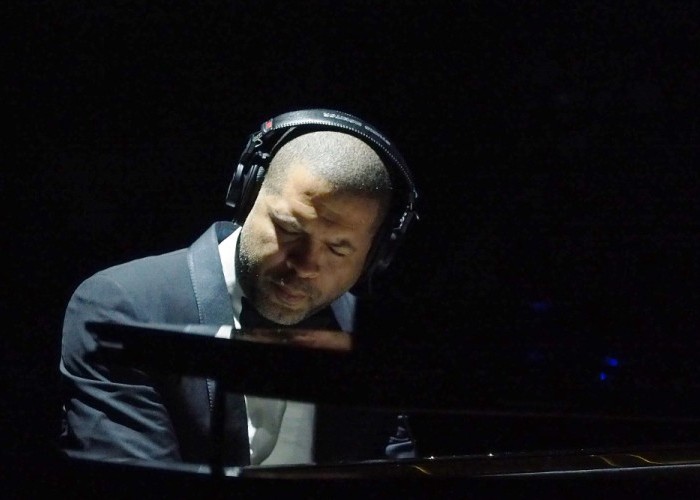Oct 28, 2025 10:47 AM
In Memoriam: Jack DeJohnette, 1942–2025
Jack DeJohnette, a bold and resourceful drummer and NEA Jazz Master who forged a unique vocabulary on the kit over his…

Jason Moran’s autobiographical Thelonious Monk homage, “In My Mind,” found him in the company of a relatively large band at Italy’s Umbria Jazz.
(Photo: Courtesy Umbria Jazz)Although the 25th anniversary edition of Umbria Jazz Winter in Orvieto, Italy, celebrated hitting a milestone Dec. 28 through Jan. 1 by booking a sizable number of eminent Italian jazzfolk, the festival maintained its customary practice of bringing prominent U.S. masters at various stages of their careers to the ancient hilltop town. The relaxed ambiance, along with acoustically superb venues, good instruments, first-rate engineers and crews, and exceptional food, was, as in past years, a recipe for aesthetic success.
It was fascinating to witness several performances of Jason Moran’s autobiographical Thelonious Monk homage, “In My Mind,” a multi-media work in which the 42-year-old pianist-composer-conceptualist-educator-curator effectively signifies upon the musical “text” of Monk’s 1959 At Town Hall on Riverside. Moran convened electric bassist Tarus Mateen and drummer Nasheet Waits from his Bandwagon trio and five horn players equally adept at improvising and creating an ensemble sound (Logan Richardson, alto saxophone; Walter Smith, III, tenor saxophone; Ralph Alessi, trumpet; Andre Hayward, trombone; Bob Stewart, tuba) to interpret, reimagine and inhabit Hall Overton’s arrangements of “Thelonious,” “Friday The 13th,” “Monk’s Mood,” “Little Rootie Tootie,” “Off Minor” and “Crepuscule With Nellie.”
The music functioned as a tone parallel to a palimpsestic video created by David Dempewolf, who manipulated it in in real-time from the soundboard. It included Monk’s instructions to Overton on how he wanted his works treated and Moran’s reflections on the pianist’s impact on the development of his own artistic consciousness. The ensembles were crisp, the solos fierce; Moran—breathing as one with Waits—played as though Monk’s spirit was riding him.
Guitarist Mark Ribot played four concerts apiece with two separate bands—a trio with bassist Henry Grimes and drummer Chad Taylor that referenced mid-1960s Albert Ayler; The Young Philadelphians, a septet that included guitarist Mary Halvorson; as well as a string trio with harmolodic funk icons Jamaaladeen Tacuma on bass and Calvin Weston on drums, that addressed repertoire associated with Philly Soul.
Ribot’s relentless rock-inflected playing in the latter context—and his parodic delivery of the lyrics—had a faux-primitive quality that evoked the rhythmic stiffness of ’80s No Wave, more deconstructive than an effort to address the subject in question, with Tacuma and Weston playing what amounted to a separate rhythm track, rather than interacting with the flow. The well-played string passages seemed superfluous. The audiences loved it, though.
At the trio’s first concert, the 82-year-old Grimes was ailing, unable to play while standing. Although he elicited the customarily mellifluous tone that is his trademark, he seemed unable to interact with Ribot and Taylor, who constructed a freewheeling dialogue marked by the drummer’s consistently imaginative beat constructions and Ribot’s stark asperity. Grimes was standing during concert three and contributed equilaterally to the flow, giving Ribot free rein to access his considerable gift for melodic creation—it was a raw, beautiful set.
For the Italian artists, melody reigned supreme. Pianist Giovanni Guidi, 32, interacted seamlessly with accomplished drumkit tone-painter Michele Rabbia and Francesco Bearzatti, an erudite, John-Coltrane-to-Ben-Webster tenor saxophonist with a vocalized tone who plays on Guidi’s just-recorded fourth ECM record. He displayed formidable chops—nuanced touch, complete left-hand-right-hand independence, harmonic freedom— working toward ensemble imperatives on an hour-long master class in spontaneously recomposing familiar themes. At a New Year’s Eve solo concert, Guidi channeled his inner Keith Jarrett on an improvisation that began at noon with an aria-like opening motif, morphed into various pathways and returned to homebase precisely an hour later.
During the festival’s final event, veteran pianist Danilo Rea reunited with bassist Enzo Pietropaoli and drummer Roberto Gatto (once his frequent partners in the Roma Trio) in a swinging, off-the-cuff, perfectly proportioned concert that spanned Charlie Parker (“Passport”), Billy Strayhorn (“Raincheck”), blue ballads (“Midnight Sun”) and the American Songbook. It was an old-master performance. So was Naples-born vocalist Maria Pia De Vito’s recital of seven Joni Mitchell songs, which she delivered with pitch-perfect, nuanced phrasing, deploying her voice seamlessly as an instrument within a think-as-one trio with Pietropaoli and pianist Julian Oliver Manzanello. She conveyed the narrative arc of each lyric with a subtlety and dramatic nuance all the more remarkable for the fact that English is not her native tongue. DB

Jack DeJohnette boasted a musical resume that was as long as it was fearsome.
Oct 28, 2025 10:47 AM
Jack DeJohnette, a bold and resourceful drummer and NEA Jazz Master who forged a unique vocabulary on the kit over his…

Goodwin was one of the most acclaimed, successful and influential jazz musicians of his generation.
Dec 9, 2025 12:28 PM
Gordon Goodwin, an award-winning saxophonist, pianist, bandleader, composer and arranger, died Dec. 8 in Los Angeles.…

Flea has returned to his first instrument — the trumpet — and assembled a dream band of jazz musicians to record a new album.
Dec 2, 2025 2:01 AM
After a nearly five-decade career as one of his generation’s defining rock bassists, Flea has returned to his first…

Nov 13, 2025 10:00 AM
For results of DownBeat’s 90th Annual Readers Poll, complete with feature articles from our December 2025 issue,…

To see the complete list of nominations for the 2026 Grammy Awards, go to grammy.com.
Nov 11, 2025 12:35 PM
The nominations for the 2026 Grammy Awards are in, with plenty to smile about for the worlds of jazz, blues and beyond.…








